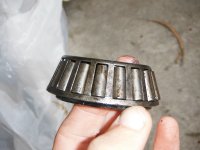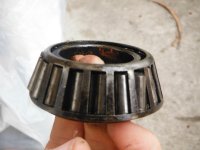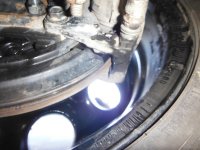OP, here's what the Dana Corporation has to say about the
strength of the Dana 44 and
Dana 60 rear axles. Some people may say use sleeves and gussets and/or weld a truss on, those components will help the housing some but do nothing to strengthen other components such as: carrier bearings, pinion bearings, wheel bearings, the ring and pinion, and the carrier. For making the tubes stronger a larger O.D. tube will have the
best effect and have the best strength to weight ratio. Some would say to add chromoly shafts to a Dana 30, but the stock shafts are more ductile and will bend and flex more instead of transferring more shock loading to the ring, pinion, and carrier.
Using large diameter and heavy tires with low backspace wheels will have detrimental effects on wheel bearings. An unbalanced load will cause excessive and uneven bearing wear. The problems with using larger tires are not just the weight, but the larger diameter will cause more centripetal force to be generated since the radius is larger. Twenty or thirty pounds may not seem like much of a mass increase, but that mass has a much larger effect when it's quickly rotating. In the case of the stock front wheel bearing, the bearing itself cannot be inspected or pulled apart without essentially destroying it. It is possible that there may be some play in the bearing or that a front wheel speed sensor may give an implausible wheel speed signal, or the bearing could just give up without much warning. I wouldn't say that it's weak, it simply was never meant to withstand such use.
I've had a rear pinion bearing give up on me. The bearing was heavily pitted and had a lot of play in it. I also have had a set 10 wheel bearing fail on me in the rear axle. The bearing seized up and generated enough heat to burn my finger when I touched the hub flange and caused the axle seal to fail. I ran LT285/75R-17 Toyo M/T's weighing in at 71 lbs for about 24,000 miles when the failures occured. Maybe I pushed the Jeep too hard, maybe Royal Purple gear oil sucks at lubricating, perhaps I'm just blessed like that? Whatever the case may be I would say it's unreasonable to expect a Dana 30 to withstand 37" tires off-road. Here's an example of a man who tried 37" tires on a Dana 30, started to build up bigger axles (Dana 60 and AAM 14-bolt), and then
blew up his Dana 30 ring and pinion before he was finished. That's just one example of what could go wrong. Whether it's on
this forum or
others people will disagree about what a good axle for large tires is. Anyone who says a Dana 30 can withstand 37" tires off-road should have analysis, documentation, or a lot of experience to back up their beliefs.



It is very possible for
axle components pushed beyond design limits to fail, and the person doing such to their vehicle should understand possible outcomes. Any cost analysis should include the possibility of recovery costs, towing costs, that the dealer might not warranty a Dana 30 with a truss welded to it running 37" tires, and any applicable repair bills, especially if the individual is not doing their own labor. Going cheap is not always cheap in the end.
Dynatrac is not the only manufacturer of better housings and assemblies. Dana makes what they call "
Ultimate Dana 60's" meant for severe off-road abuse,
Solid Axle makes good assemblies, and of course
Dynatrac does also. There are many factors to consider and it may take some time to properly analyze what people tell you. This is not the only place where people will say changing every part on a front Dana 44
is not necessarily much cheaper than a Dana 60 or would put a lot of faith in a Dana 30 with 37" tires. Good luck with whatever you decide OP.



